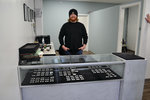Ed Helgran of Atwood Coin & Jewelry, at 1450 Atwood Ave., has a piece of advice for young people looking to take up a hobby.
“You can buy a coin today that may 20 years from now be …
This item is available in full to subscribers.
We have recently launched a new and improved website. To continue reading, you will need to either log into your subscriber account, or purchase a new subscription.
If you are a current print subscriber, you can set up a free website account by clicking here.
Otherwise, click here to view your options for subscribing.
Please log in to continue |
|



Ed Helgran of Atwood Coin & Jewelry, at 1450 Atwood Ave., has a piece of advice for young people looking to take up a hobby.
“You can buy a coin today that may 20 years from now be worth $100,000 because of its scarcity, which, you’ll never get that kind of return just [with bullion],” he said. “Coin collecting is a great hobby to get into as a kid, if you can get your kids into it because it’s an investment in their future.”
Both Helgran and Steve Melucci, owner of Gold & Silver Jewelry Outlet at 1527 Post Road in Warwick, agreed that the gold and silver markets are doing well. Helgran did add, though, that he sees gold and silver jewelry as being a “terrible investment” because of their markups. He recommended becoming involved with certified gold coins and bullion. He said the market is trending more toward bullion, but coins have become the better investment.
“More or less the biggest change in the past 40 years is, people don’t realize that collecting high-grade gold and silver coins are a much better investment in the long run than just plain bullion,” said Helgran, who has been in the business four decades.
Melucci said the gold and silver markets are at six-year highs, and during the first week they spiked a month ago, the floor was flooded with people looking to take advantage. He said he used to be able to get U.S. $20 gold pieces for $200, but now they go for closer to $1,500.
He’s familiar to the industry’s swings. Melucci has operated businesses on both coasts, tending to a shop in California before working his way to the Ocean State. He deals with collectible comic books and baseball cards, too, and the difference between selling a Mickey Mantle card for $50 or $300 is a small, key number.
“Everything now is graded,” Melucci said. “You can’t get a top price without getting your pieces graded. Pokemon’s hot. It’s been hot for a long time. Any high-grade Marvel comics, Superman comics, the usual baseball [cards], the usual subjects like [Mickey] Mantle and any of those. [If] they’re graded, they’re worth a lot of money, but if you get a Mantle card that’s graded like a four, which is a low grade, it’ll sell for $300 graded.”
As for some of his pricier memorabilia, Melucci said he once had a 1933 Babe Ruth card worth $3,000. He also possesses a Bill Russell rookie card – which has yet to be graded – and once purchased a 1914 World Series pin.
He said that baseball card collectors, for example, have become more like stock traders, waiting for the market to hit a high point.
“They’re like guys buying stocks,” Melucci said. “They trade them back and forth when it goes up, whatever. It takes a lot of the fun out of it for being a collector, but that’s because I’m a collector/seller. If you’re just a collector, then you don’t worry about any of the prices or any graded things like that because you don’t need a grade-nine Mickey Mantle which costs thousands of dollars, because you don’t care. You’re not doing it to resell it.”
Making the grade, so to speak, depends on which companies are trusted the most. Melucci said he deals with PSA, or Professional Sports Authenticator, regarding baseball cards, but said the process is expensive and takes at least a month to complete.
Helgran said, in his business, the companies PCGS, or Professional Coin Grading Service, and NGC, or Numismatic Guaranty Corp., are the only “two companies that actually are worth their weight.”
“When they say it’s this [grade], it’s this,” Helgran said. “There’s no arguing. So if you go to sell it, you now have something that’s certified by one of the two best companies, and their word is good.”
Getting a good grade is more important than ever, too, because Melucci said every collectible has a lifespan. If they sit in a drawer or on a shelf collecting dust, without receiving that coveted seal of approval, they could miss their high point.
“Collectibles are like people,” Melucci said. “Just like a person, you have your high point or as good as you can be, and then you’re on your way down. And I tell people that with baseball cards that aren’t graded, you need to sell some of those older guys now because in 20 years nobody will even know who they are. You’ll get nothing for them. Same thing with comic books, too, if they’re not graded.”
Helgran said the future of the industry could be especially prosperous, but it depends on the economy and the dollar. If everything breaks right, gold could “skyrocket” and silver could double in price in the next five to 10 years.
If anyone knows someone trying to get into the coin collecting business, though, Helgran said he could offer some advice.
“Stop down and talk to me, because there’s just so much to know about it,” Helgran said. “Start with what you can afford to just put away in the bank, and when you do buy high-grade, you want to get certified coins.”
Comments
No comments on this item Please log in to comment by clicking here